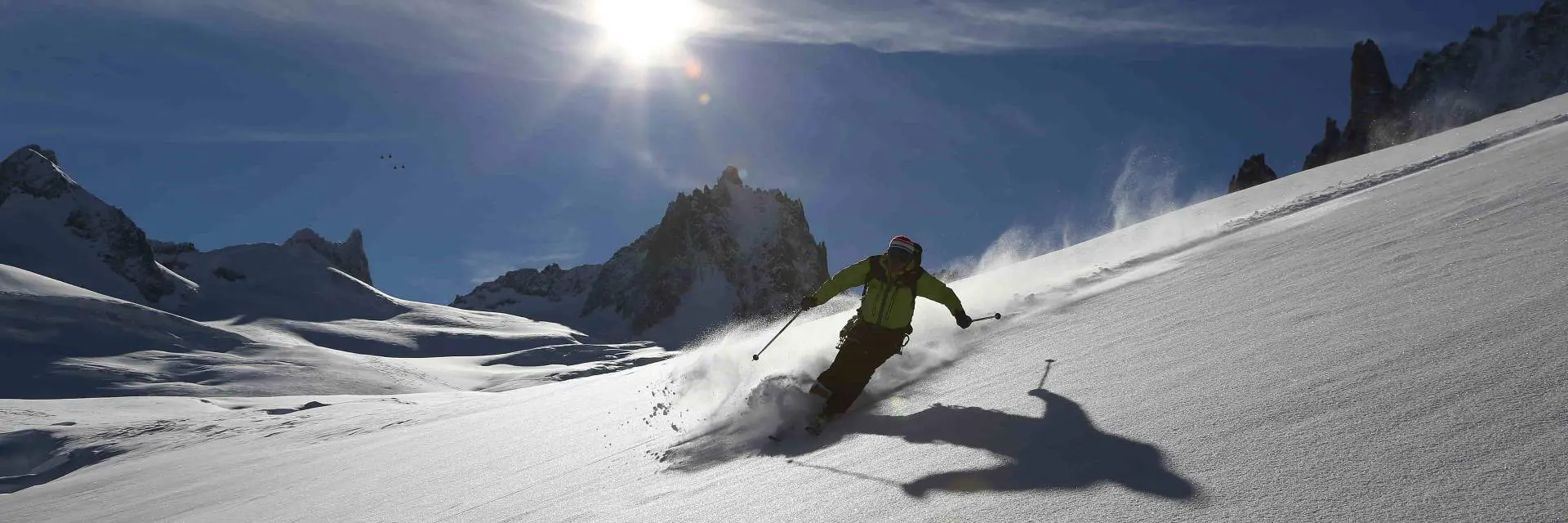
The Vallée Blanche, for me, is what skiing is all about. If you’re in Chamonix and you’re a confident intermediate skier, this run is a must. It has everything; it’s exciting, the views are amazing, it’s challenging yet accessible, and although you’re just a cable car ride from the centre of Chamonix, you get that backcountry expedition feel.
In terms of features it has every type of skiing you could possible want: steeps, ice, powder, couloir. You could do the Vallée Blanche every single day for a week and never get bored. For most people it takes a full day to get down, and to really enjoy it you need to be quite fit, but honestly it provides most satisfying skiing I’ve ever experienced.

Hiking down to the start of the Vallée Blanche from the Aiguille du Midi | © Patrik Lindqvist
Vallée Blanche overview
The Vallée Blanche is a 23 km descent covering a massive 2800 m vertical drop from the Aiguille du Midi (3842 m) back to Chamonix (1050 m). You can finish the run either at the Montenvers-Mer de Glace mountain railway terminus, or if there’s enough snow, you can ski all the way back down to Les Planards in Chamonix. Allow plenty of time. If you take regular breaks, the round trip from Chamonix takes from 4 to 6 hours and there can be a fair bit of waiting around, either at the Aiguille du Midi cable car or for the train back to Chamonix.
How difficult is the Vallée Blanche?
If the weather and snow conditions are good, the Vallée Blanche is accessible to intermediate skiers and advanced snowboarders. If visibility isn’t great, it’s foolish to attempt the descent. Besides the danger, you’ll miss out on some of the most spectacular scenery that the Mont Blanc massif has to offer.
Skiers
The classic Vallée Blanche route isn’t technically difficult and the run would be graded red if it was in a resort. If you’re a confident off-piste skier and you can control your speed and trajectory on steep gradient and varying snow conditions, you’ll be fine. However, it’s length means you do need to be physically fit and able to ski for a sustained period.
Snowboarders
Snowboarding will generally involve a more direct route to avoid flat sections on the upper part of the mountain. Typically that means you’ll take the Petit Envers du Plan route, which is a more difficult route than the classic ski run and requires the ability to ride an off-piste black. Make sure your board is waxed and your edges sharpened, as you’ll want as much glide as possible on flat sections, and you’ll want plenty of bite on steep icy sections. You’ll also need to bring a telescopic ski pole to help push along the Mer de Glace section towards the end of the route.
Kids
The Vallée Blanche descent is not recommended for young kids, even if they’re very good skiers, mainly because of the cold and fatigue. Parents should make the call based on the snow and weather conditions, and the skiing ability and physical fitness of their children.
Do you need a guide for the Vallée Blanche?

Snowboarder Pete Murtagh and guide mid-way down the Vallée Blanche | © Ultimate France
Unless you and everyone in your party are very experienced backcountry skiers, then take a guide. You’ll have way more fun with a guide and you are way less likely to die, both of which are important considerations. You’ll hear it said that the Vallée Blanche is basically a 20 km red run, and it’s true that the classic route isn’t technically difficult, but those people are forgetting that this is high mountain off-piste skiing and hazards including avalanches, crevasses and rockfall are very real.
Your guide will know the terrain well, he or she will assess your ability within the first few hundred metres and tailor the route accordingly. An experienced guide will know every inch of the terrain and they’ll recognise when there’s been a shift in the ice and choose a new safer course. They’re also passionate about the mountains, and a good guide will happily do the geography teacher bit, if you’re interested. They’ll tell you about the ice structures, the movement of the glacier, the surrounding peaks.
A guide will cost about 75 € per person for a group of four. That’s a small price to pay for an experience that will stay with you forever.
Book a Vallée Blanche ski guide
Our ski guiding partners in Chamonix use some of the best local UIAGM-qualified mountain guides with years of experience leading backcountry expeditions in the Mont Blanc range. You guide will draw on their professional experience and local knowledge to tailor the route to the ability of your group and the conditions on the day, enabling you to enjoy the magnificent scenery in safety. A Vallée Blanche trip will cost about 300 € per group of 1-4 people. Take a guide, you’ll be safer and you’ll have a lot more fun.
Vallée Blanche Guiding
Starting high above Chamonix at the iconic Aiguille du Midi, your guide will provide instruction and all the necessary safety gear, so you and your group—up to a maximum of eight participants—can enjoy a tailor-made route suited to your level of skiing.
Ski the awesome backcountry terrain alongside some of the Mont Blanc’s most incredible glaciers. After descending 20 km to the legendary Mer de Glace, it’s just a short 20-minute journey back to Chamonix.
The Aiguille du Midi Arête
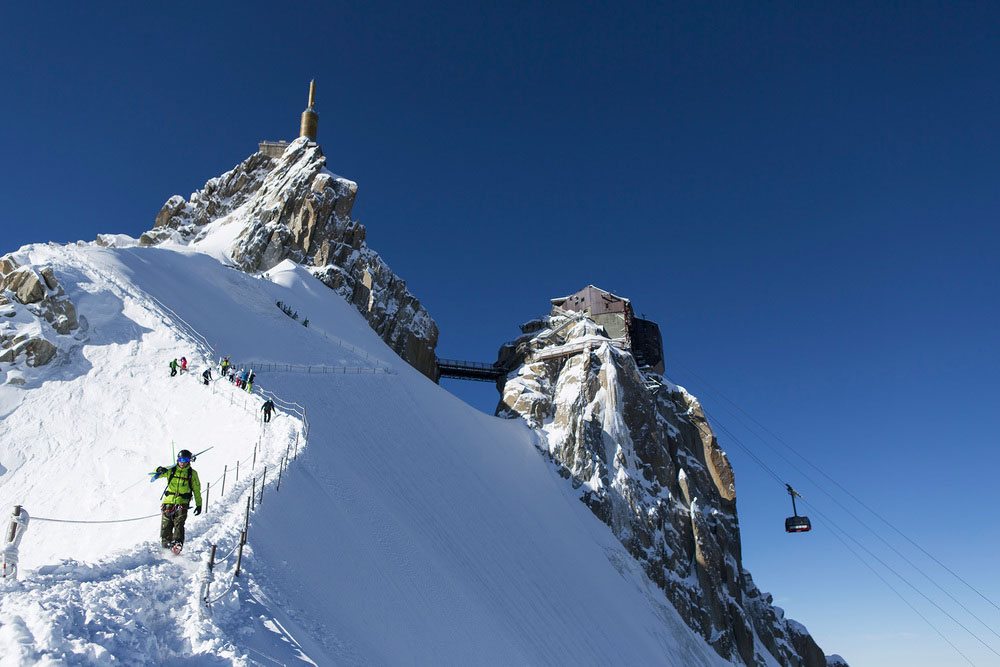
Between the top of the Aiguille du Midi cable car and the start of the Vallée Blanche descent, you must negotiate the infamous arête. The ridge runs along the north face of the Aiguille du Midi, with its 1500 m vertiginous drop down to Plan d’Aiguille and Chamonix a further 1000 m below that.
To help the thousands of skiers who descend the ridge to access the Vallée Blanche each winter, a path is cut into the snow and a safety rope is rigged up. In good conditions climbing down the ridge requires caution, but with a guide and proper use of safety equipment it’s quite straightforward.
However, fatal accidents happen every year. On the 18 May 2013 at about 9:00 pm in the evening, two British skiers were trapped in a storm at the top of the Vallée Blanche. They alerted the emergency services but the bad weather prevented them from being able to mount a rescue.
Unable to continue down, the two men decided to climb back up the arête to the Aiguille du Midi and the safety of the lift station. The conditions on the arête were bad. Heavy snowfall meant that the arête path was filled in and the safety rope was buried. Strong winds blasted snow over the ridge from the Vallée Blanche side and the wind-chill brought the temperature down to -16ºC.
One skier, communicating on a mobile phone with the guardian of the Aiguille du Midi, was guided up the summit ridge to the safety of the Aiguille du Midi complex. The second skier suffered a fatal fall down the North Face of the Aiguile du Midi. His body was recovered by the mountain rescue early the next morning during a break in the bad weather. Source: Le Dauphiné
Map of the Vallée Blanche Ski Routes
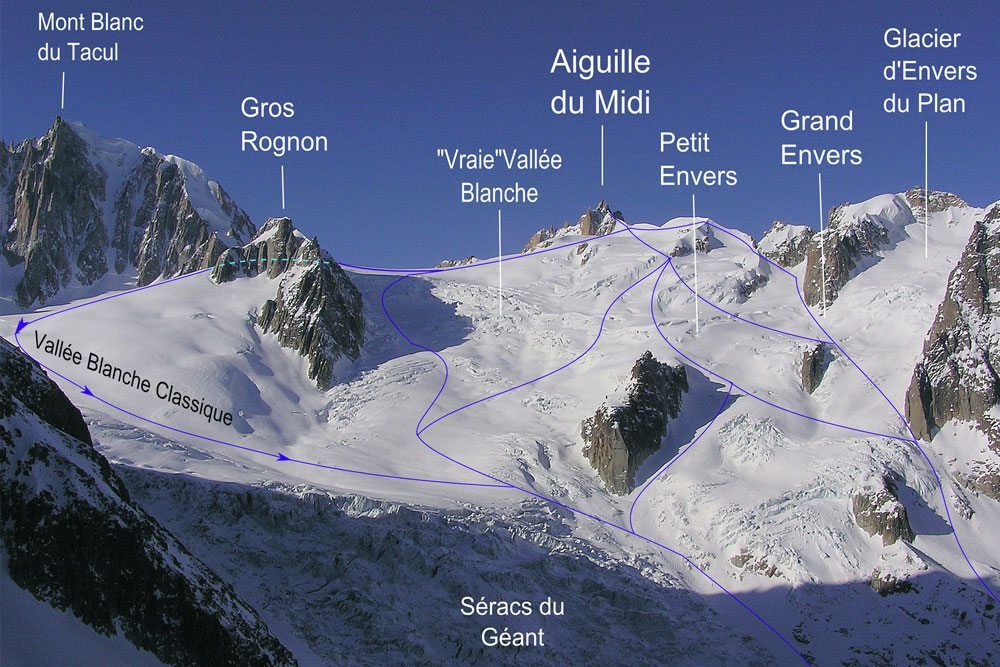
1. Voie Normale (the classic ski route)
The Voie Normale is technically the easiest route and it’s by far the most popular. It follows the line of least gradient through a labyrinth of glaciers, including Géant, Tacul and the famous Mer de Glace.
From the top of the Aiguille du Midi cable car, it’s a 200 m climb down the notorious Arête before you you put skis on. This is the most dangerous part of the whole trip. The 2000 m drop down the north face of the Aiguille du Midi helps focus the mind! If you’re with a guide, he or she will be wearing crampons and you’ll be roped up together. Despite the saftey rope, if your group is attempting the descent without a guide, it’s wise to do the same.
At the end of the ridge there’s a flat area where you can put your skis on. With the ridge out of the way, you can now focus on the skiing and you’ll be filled with excitement as the magnificence of the surrounding peaks and the high mountain terrain ahead takes a grip of your senses.
The first few hundred metres are magic. You’ll drop down in front of the south side of the Aiguille du Midi and traverse a wide open powder field in the cusp of the Mont Blanc towards a stack of rock called the Gros Rognon. In the shadow of the Mont Blanc du Tacul, you’ll turn a sharp left onto the Tacul Glacier and staying well to the left you’ll ski alongside impressive ice features such as séracs, crevasses and ice caves.
Traversing north across the Tacul Glacier, the route narrows as you approach the steepest section of the Voie Normale. Snow bridges cover crevasses beneath you and your guide will ask that you stay within his or her tracks. Staying left you’ll pass beneath the Dent du Requin peak and arrive at the Refuge du Requin (2516 m), a popular place to stop for lunch.
Facing the Séracs du Géant you drop down to a section of glacial moraine named La Salle à Manger and here the route takes you back across the Tacul Glacier, passing alongside beautiful séracs, to reach the confluence with the Mer de Glace.
There’s an opportunity here to use the gradient to pick up a bit of speed and run out as far as possible without having to push. This is all the more relevant for snowboarders who will want to avoid having to use their ski pole for as long as possible…
The last part of the Mer de Glace consists in skiing through amazing halfpipes sculpted by the flow of melting ice in the summer. Loads of fun!
From here, there are two options to get back to Chamonix. Either take the gondola up to the Montenvers station (1913 m) and take the mountain railway 20 minutes back to Chamonix, or if snow conditions allow, you can ski for a further hour down to about 1600 m and climb the 50 m up to the La Buvette des Mottets. After a well earned rest and refreshment, follow the forest trail marked ‘Sortie Vallée Blanche’ back to Chamonix.
2. Petit Envers du Plan
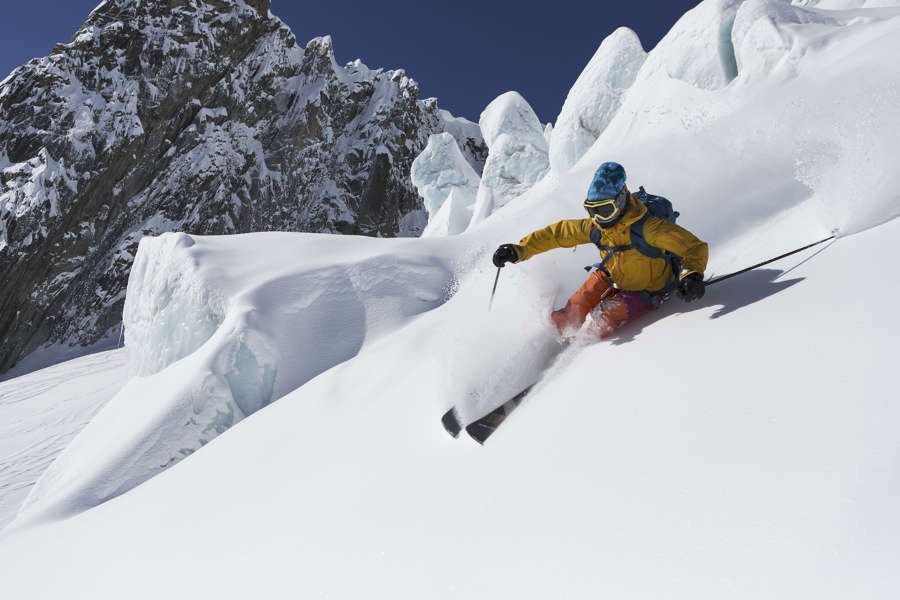
The Petit Envers du Plan is a more challenging route than the classic run and includes more sustained steep sections that wind through a labyrinth of impressive ice formations. Less frequented, you’ll have a greater chance of finding untracked powder, all set to a backdrop of the Talèfre and Géant glaciers. To safely tackle the Petit Envers route, you’ll need to be a strong and confident off-piste skier.
3. Grand Envers du Plan
The Grand Envers du Plan is the steepest and most technical of the commercially run Vallée Blanche routes. It’s also one of the most beautiful. This itinerary requires you to ski sustained slopes of 40-50 degrees, stopping only on places indicated by your guide. You’ll need to be a solid off-piste skier with full control of your skis over varied terrain.
The top section to be able to ski fully committed on steep slopes up to 45°. This route is paradise for expert skiers. You’ll love the combination of skiing steep powder, navigating crevasses and negotiating narrow technical sections.
You’ll ski from the Aiguille du Midi all the way down to Chamonix via the following route:
From the narrow ridge that separates the Aiguille du Midi from the Col du Plan you’ll drop into the first steep slope. Then from Le Gros Rognon (3532 m) you’ll hit the second steep slope down to the Glacier de l’Envers du Plan and on to the Refuge du Requin where you can take a break and try some local mountain specialities. From the refuge you have the option to ski a number of different couloirs that vary in steepness, before arriving onto the Mer de Glace and joining the classic Vallée Blanche route. Finally, after a well deserved refreshment at the Mottets hut and if conditions allow, you’ll ski the narrow forest descent into Chamonix.
4. Gros Rognon
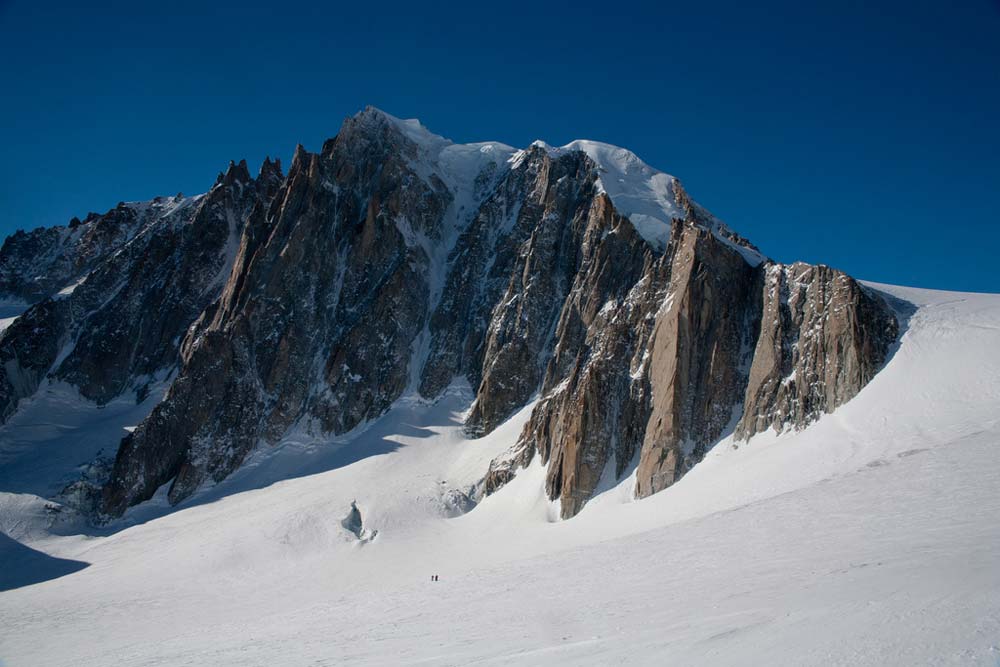
Mont Blanc du Tacul. Believe it or not, people ski the couloir down the middle! | © Flickr – mll
The Gros Rognon deviates from the classic route just before the huge stack of rock by the same name. Dropping down more directly towards the Séracs du Géant, you’ll access less frequented and steeper terrain where there’s a good chance you’ll find some untracked snow. Despite the extra gradient, it’s still suitable for intermediate off-piste skiers.
5. Toule and the Vallée Noire
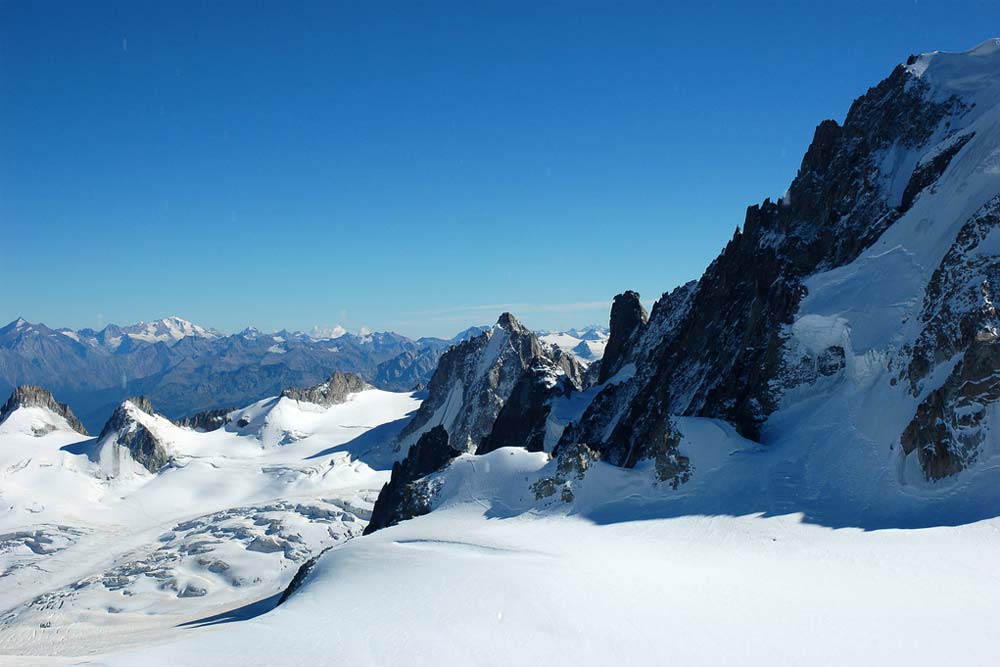
Glacier du Géant & Mont Blanc du Tacul | © Flickr – Richard Jones
This route starts on the Italian side of the mountain. It’s a long and technical route requiring solid skiing ability and endurance. If you have what it takes, you’ll be able enjoy what’s regarded as one of the best off-piste skiing itineraries in the Alps.
Toule glacier is located on the south face of Helbronner point, right on the France-Italian border and this is the starting point of the Vallée Blanche from the Italian side. To get there from Chamonix, you need to go through the Mont Blanc tunnel and then make your way to the Skyway 380°. This is the Italian equivalent of the aiguille du Midi cable-car and takes you up to Pointe Helbronner (3462 m) in just a few minutes.
After a short descent, you traverse 100 m to reach the col de Toule. From there, you take the impressive 150 m high metal staircase to reach the start of the Toule Glacier.
The descent on the South Face is great fun, never too extreme and with lots of options for carving your own lines in the powder! After a whopping 1300 m vertical drop, the descent finishes at the Pavillon (mid-station).
After a nice Italian lunch at the restaurant on the mountain it’s time to take on the epic 20 km Vallée Blanche descent via the pristine Aiguille Noire route.
This itinerary will takes you first down the right-hand side of the Glacier du Géant, then to the Glacier du Tacul, and finally you rejoin the classic Vallée Blanche route and the Mer de Glace.
Vallée Blanche Kit List
Ideally, you’ll want to use freeride or all-mountain skis such as Dynastar Cham’s or K2 Pinnacle’s. Snowboarders will want to use an all-mountain board that will float through powder and have plenty of glide through flat sections. Make sure your skis or snowboard have recently been serviced and are waxed and edged ready for the day.
Bring a technical backpack that is configured to hold your skis or snowboard. Good ones are the Osprey Kode or Patagonia Snow Drifter. You’ll need it for the climb down the arête, any boot packing you need to do, and the walk up to La Buvette des Mottets.
In your backpack you should have plenty of water, energy bars and a picnic, a first aid kit, a head torch and an extra layer of clothing.
Your guide will kit you out with a harness so you can be roped up for the Arête and in the event of a rescue, and an avalanche transceiver, probe and shovel.
Your guide will carry a rope and crampons, and depending on the conditions on the arête, he or she may ask you to rent some crampons as well. If that’s the case, think about setting them up for your boots before you get on the mountain.
Snowboarders should also bring telescopic poles for the final push over the Mer de Glace.
Please leave a comment below if you need specific advice for your Vallée Blanche trip, or if you have any recommendations to help us improve this guide. Happy holidays!


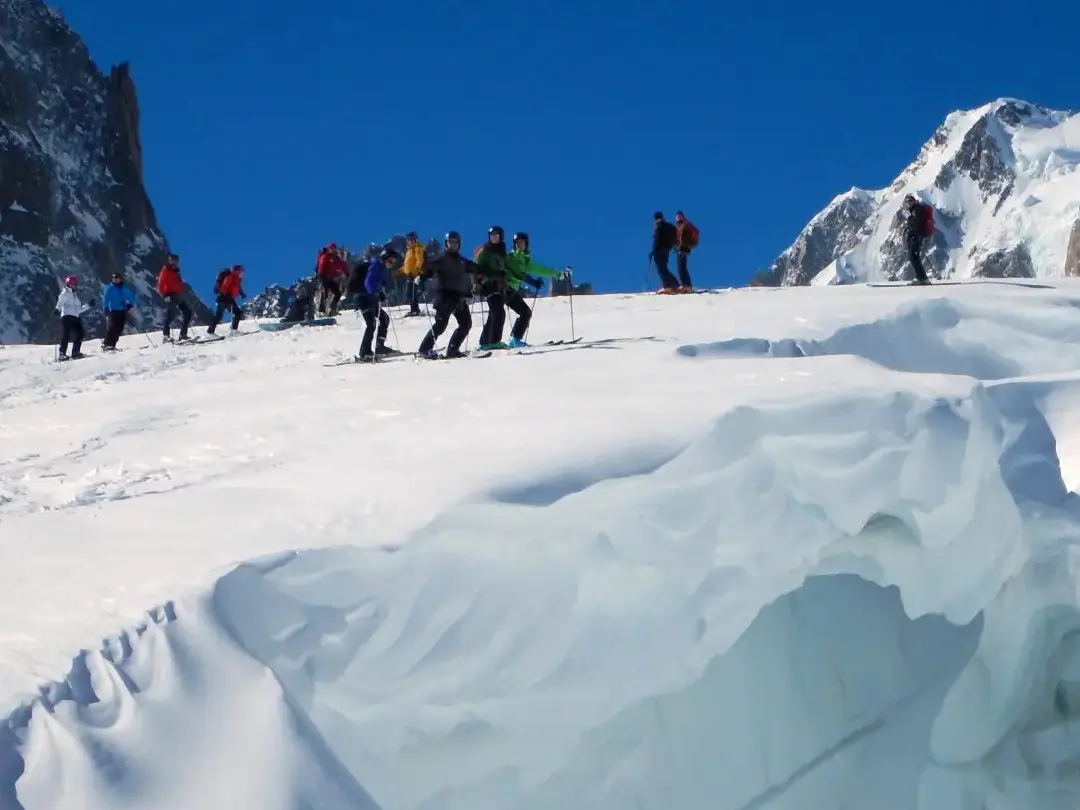
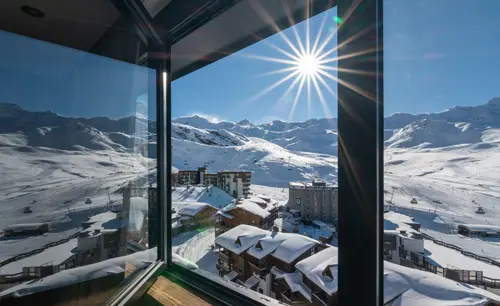

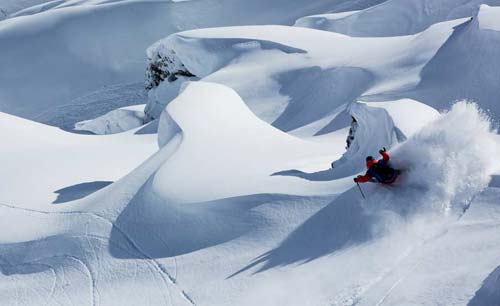


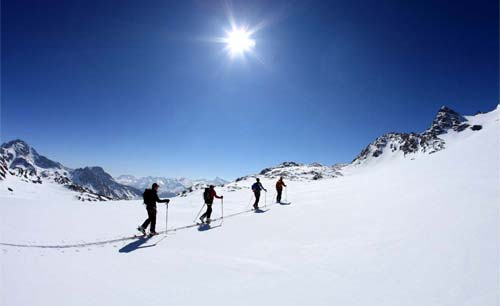
Hi,
I have a couple of questions:
1) If I don’t own a backpack that can carry skis can I still do the run?
2) How long will I actually be skiing on the run?
Hi Benji,
Thanks for your comment! Great questions.
1. Yes, you can still do the run if you don’t own a backcountry pack. However, you will have to carry your skis at certain points during the day, so I’d recommend buying a ski-carrying strap on Amazon.
2. The descent can take anywhere from 2 to 6 hours, depending on the snow conditions, weather, and your skill level. So, I’d recommend you allow a full day.
Hope that helps, have a great trip!